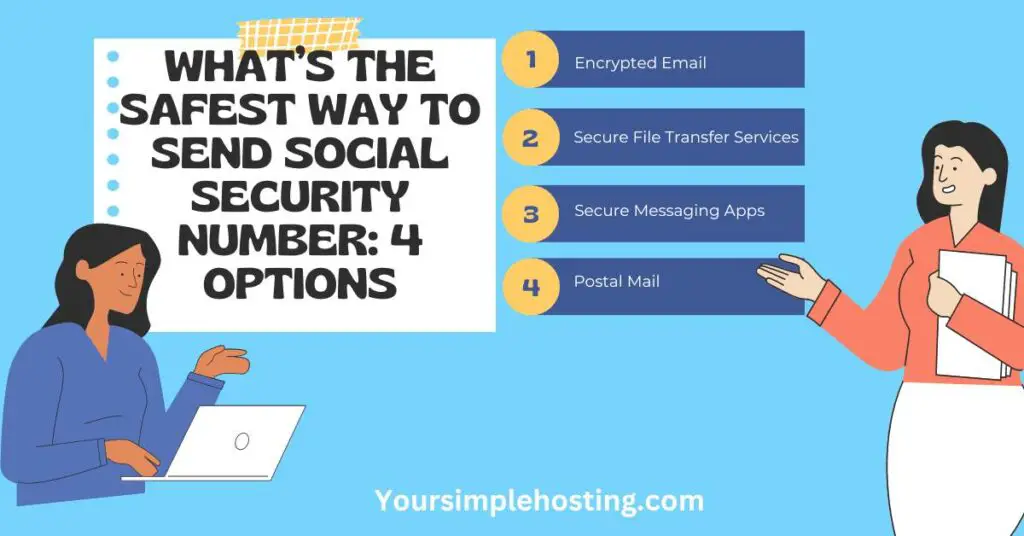Sending sensitive information like a Social Security Number (SSN) via email can be a nerve-wracking experience, especially in today’s digital age, where data breaches and cyber threats occur regularly.
However, you can safely send your SSN and protect yourself and your recipient from potential risks. In this article, I’ll guide you through the steps to send your SSN safely via email.

Table of Contents
Is it Legal to Send a Social Security Number by Email?
No specific law prohibits emailing a Social Security Number (SSN). However, it’s generally not recommended to do so, as email communication isn’t 100% secure.
Email messages can be intercepted or accessed by unauthorized persons, potentially exposing sensitive information to identity theft or fraud.
The Social Security Administration advises against sending sensitive information like SSNs by email and recommends using secure methods, such as encrypted email or sending it via mail or fax.
Additionally, some states have laws regulating SSN transmission and may require additional security measures.
Before sending sensitive information by email, consider the risks and take appropriate security measures to ensure the information is being sent safely and securely.
How to Send Social Security Number Safely via Email: 7 Safety Tips
Sending sensitive information like a Social Security Number (SSN) via email can be risky. However, you can ensure your sensitive information is sent safely and securely by following the following steps:
1. Use Encrypted Email Services
Encrypted email services add an extra layer of security to your email communication.
Encrypted email services like ProtonMail and Tutanota are free and offer end-to-end encryption, which ensures that only the sender and the recipient can read the email.
Use a strong and unique password for extra security.
If you want to know which email providers offer the best security check out my other article about which email providers has the best security.
2. Use Password-Protected Attachments
Another way to safely send sensitive information like an SSN via email is by using password-protected attachments.
You can use tools like 7-Zip or WinRAR to create a password-protected archive of the SSN file.
Then, you can share the password with the recipient via a separate communication channel, like a phone call or a text message.
3. Split the SSN Into Parts
You can split the SSN into two or more parts and send each in a separate email.
For example, you can send the first five digits in one email and the last four in another email. This way, even if one email is intercepted, the hacker won’t have access to the full SSN.
4. Send the Email From a Secure Network
Make sure that you’re sending the email from a secure network.
Avoid sending sensitive data over public Wi-Fi networks, as they’re often unsecured and can be easily intercepted.
Instead, use a secure private network like your home or office Wi-Fi.
5. Verify the Recipient’s Email Address
Before sending the email, ensure you send it to the correct recipient.
Verify the recipient’s email address to avoid sending sensitive information to the wrong person. A simple typo can send the SSN to the wrong person, which can be dangerous.
6. Keep a Copy of the Email
Make sure to keep a copy of the email for your records. This way, you can track when the email was sent and to whom it was sent. In addition, you’ll have a record of the email in case of any discrepancies.
7. Follow Up With the Recipient
Follow up with the recipient to ensure they have received the email and the SSN is secure. This is especially important if the SSN is needed for a specific purpose, like a job or loan application.

What’s the Safest Way to Send Social Security Number: 4 Options
The safest way to send a Social Security Number (SSN) is to use a secure method of communication that uses encryption to protect the data from unauthorized access.
Here’s a list of options:
1. Encrypted Email
Sending an encrypted email is one of the most secure ways to send sensitive data like your social security number.
Encrypted email services use end-to-end encryption, ensuring the intended recipient can only read the message.
Some popular encrypted email services include ProtonMail, Tutanota, and Hushmail.
2. Secure File Transfer Services
Secure file transfer services allow you to send large files securely, including sensitive information. These services use encryption to protect the files during transmission and storage.
Well-known secure file transfer services include Dropbox, Google Drive, and OneDrive.
3. Secure Messaging Apps
Secure messaging apps like Signal and WhatsApp offer end-to-end encryption, a good option for sending sensitive information. These apps also provide other security features like self-destructing messages and two-factor authentication.
4. Postal Mail
Sending your SSN via postal mail may seem old-fashioned, but it’s still a secure method of communication.
Send the mail via certified mail or with a return receipt to confirm the intended recipient received it.
Frequently Asked Questions (FAQs)
Is it Safe to Send SSN Over Gmail?
Google takes security seriously and offers various security features, such as two-factor authentication, transit encryption, and rest encryption.
However, there’s still a risk of interception or unauthorized access to your account.
You can minimize the risk by using encrypted email services or sending sensitive data via password-protected attachments.
Is it Safe to Fax a Social Security Number?
Fax communication is generally more secure than email or text messaging. However, there is still a risk of interception or unauthorized access to the fax transmission.
To minimize this risk, ensure that the fax machine is secure and that only authorized personnel can access it. Additionally, you can call the recipient to confirm that they have received the fax.
Is it Safe to Send a Social Security Number by Text?
Text messaging isn’t considered a secure method of communication for sensitive data because text messages aren’t encrypted.
There’s a risk of interception or unauthorized access. If sending sensitive data via text message is necessary, it should be sent via a secure messaging app that offers end-to-end encryption.
Conclusion
Sending your Social Security Number over email doesn’t have to be a daunting task.
Following the steps above, you can ensure your important data is sent safely. Always take precautions when sending sensitive data and use trusted and reliable methods.
Protecting sensitive information is vital in today’s digital age, and taking the necessary steps to do so is well worth the effort.

Leave a Reply